The world's first large-scale implementation of new innovative photon detector is underway at T2K, the Tokai-to-Kamioka second generation long-baseline neutrino oscillation experiment. In this article, we tell the story of how it came to be and what it will achieve. |
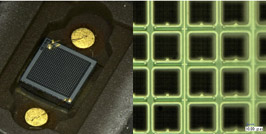
MPPC's 26 x 26 pixels in 1.3 x 1.3 millimeter square will probe the inner workings of neutrinos.
|
 |
For researchers working at an experiment designed to detect fast-moving particles with tiny masses, it is crucial to have small, high-resolution, high sensitivity photon detectors. The Tokai-to-Kamioka (T2K) second generation long-baseline neutrino oscillation experiment, designed to detect just such very small and very fast particles, needs lots of these sensors. The goal of the T2K experiment is to observe neutrino flavor change, called neutrino oscillation. To do this, physicists observe the neutrino beam at near detectors, then send the beam underground to Kamioka 295 kilometers away, where changes in the beam will be observed at the 50,000-ton water tank neutrino detector, Super-Kamiokande. Super-Kamiokande detects neutrinos with 11,146 photo detectors called photomultiplier tubes (PMTs), while the near detector hall at the Japan Proton Research Complex (J-PARC) will contain 60,000 cutting-edge photon detectors called multi-pixel photon counter, MPPC.
The MPPC is a new silicon photomultiplier diode developed by Hamamatsu that amplifies photon signals and converts them to electrical signals. In the detector material, electrons excited by incoming photons are accelerated in a strong electric field applied to a region in the device. These electrons have enough energy to liberate other electrons, creating avalanche multiplication. The avalanche photodiode (APD), known for this mechanism, operates in what is called Geiger-mode at above the breakdown voltage. In Geiger-mode, the device can trigger a stronger avalanche at a signal gain of more than 105. The Geiger-mode APD, however, cannot count multiple photons arriving at the same time. To enable the sensor to count incoming-photons, researchers from Russia developed a design that connects these photodiodes in parallel. The high gain of the Geiger-mode APD also solves the problem of electrical noise. The final product developed by Hamamatsu Photonics, MPPC, is based on the same concept, operates at room temperature, and is compact. Unlike PMT, MPPC can withstand in a strong magnetic field, which makes it a perfect fit for the near detectors at T2K.
 |
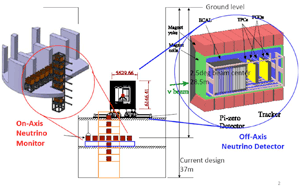
The T2K's experimental hall. The off-axis ND280 detector (right) and the on-axis INGRID detector (left).
|
Since 2008, Hamamatsu has produced sixty thousand MPPCs for T2K, which were successfully supplied to the T2K groups. Some detector components with MPPCs have traveled to Canada, England, France, and the US for test, and have since come back to be installed into the neutrino experimental hall that sits 280 meters from the target station. The experimental hall has two detectors in two slightly altered directions with respect to the neutrino beam, called the off-axis detector and the on-axis detector. Here, the 'axis' refers to the axis of the neutrino beam.
The T2K's
neutrino beamline sends a beam into the earth 2 to 2.5 degrees downward from the direction of Super-Kamiokande, (which makes it 3 to 3.5 degrees below the earth's surface). Physicists do this to narrow down the energy distribution of neutrino beams to the range where neutrino oscillations would most likely occur. To determine the profile of the neutrino beam in detail, physicists will monitor the intensity and direction of the beam at the on-axis detector. They will determine the energy spectrum, flux, flavor, and interaction cross-sections at the off-axis detector.
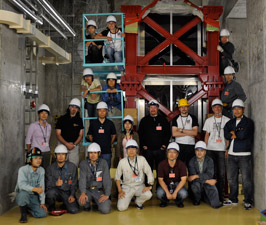
The INGRID team celebrates the installation of fourteen INGRID units in August. Dr. Akihiro Minamino of Kyoto University (lower center) is the INGRID team leader.
|
 |
Physicists call the off-axis detector the ND280 off-axis detector. The largest piece of this detector is a bus-sized magnet that surrounds most of the detector components. When entering the ND280, the beam passes through a series of detector components: the electromagnetic calorimeter (ECAL) that surrounds the neutral pion detector (P0D), the time projection chamber (TPC), the fine grained detector (FGD), a second TPC, a second FGD, a third TPC, and then the downstream ECAL (DSECAL). There are also the side muon range detectors (SMRDs) placed between the magnet yokes to detect the muons going out from the sides of the detector. All these components except the magnet and the TPCs employ MPPCs.
One and two floors below the ND280, fourteen identical iron and scintillator detector units form a cross seven units high and seven units wide. The giant cross faces the direction of the target station and profiles the beam within 5 meters in radius. This interactive neutrino GRID detector, called INGRID, also has 10,000 channels of MPPCs.
 |
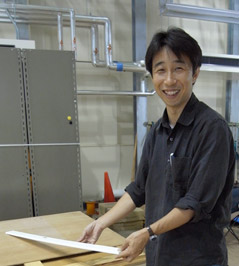
Prof. Tsuyoshi Nakaya of Kyoto University, the leader of the near detectors team, holds a scintillator strip. Through it runs a wave-length shifting optical fiber, which will be attached to an MPPC.
|
When Prof. Tsuyoshi Nakaya of Kyoto University and his team started the designs for the near detectors, there was no precedent for such large-scale usage of MPPC's. In fact, there was no such thing as an MPPC at all. All they had were some prototype detectors developed by Russian researches and Hamamatsu. From this small start, a team of physicists and engineers from the photon sensor group of the KEK detector technology project (KEKDTP) including Kyoto University and Hamamatsu put their heads together and came up with a variety of possible designs for a new type of photon detector that could be used in the T2K's near detectors, the Belle experiment, the future linear collider, and others beyond nuclear and particle physics. It was only in 2005 that the photon detector was named MPPC.
As team leader of the T2K near detector team, Nakaya had three choices for the photon detectors at the very heart of their neutrino detector technology: multi-channel plate-PMT (MCP-PMT), APD, and MPPC. The MCP-PMT was much too voluminous, and also overly sensitive to magnetic fields. The APD had severe thermal noise, and needed to be kept cool. The MPPC, on the other hand, was much smaller, had no issues of background noise because of its much smaller noise-to-signal ratio, and was less expensive. "It was an experiment," says Nakaya. "We had only two years for research and development, and the MPPC was a new technology that had not yet been tested." In the end, they chose to use MPPCs, and they did so for all components that required photon detectors.
With this decision in 2005, a group of research and development collaborators from Russia, Japan, and Canada designed and tested half a dozen sample MPCCs. Two years later, the collaborators finally nailed down a single design for a 1.3 x 1.3 millimeter square sensor that has an array of 26 x 26 pixels. Each pixel amplifies signals by a factor of 106. This design was adopted by the project as a whole, and was applied to all five detector components. Now, a total of around 50 detector physicists from Canada, England, France, Japan, Poland, Russia, and the U.S. are looking at cosmic rays to check MPPC functioning, wirings and electronics for their detector components. "We've confirmed that most channels in the first FGD are working as we expected," says a graduate student at Kyoto University, Kei Ieki. The team is now working on the second FGD. "We will be well prepared for the fall run and the data-taking in winter."
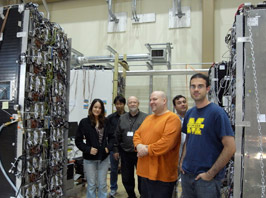
P0D collaborators are getting ready to install the P0D detector, which uses 15,000 MPPCs, in the ND280 next month.
|
 |
Now, these detector components that required miles of traveling and years of research and development are being installed in the T2K experimental hall. The SMRD is already in and being tested. Installation of INGRID was completed last month. Last week the team just installed the P0D. The team will install FGD, ECAL, and TPC in October. "All things considered, it is actually amazing how everything has been carried out on a tight schedule in such large collaboration among many nations," says the near detector technical coordinator Prof. Toshifumi Tsukamoto of KEK.
In fact, the T2K's near detector team is a collaboration of more than 200 physicists and engineers from 12 nations working at the frontier of neutrino science and technology. The development of the MPPC alone has already brought much innovation to the world. In 2007, KEK's detector technology project group, the T2K photon detector team, and the international linier collider (ILC) group held a conference in Kobe, Japan, for the purpose of offering a venue to discuss the application of MPPC to T2K. The conference, however, attracted experts from around the world. In addition to T2K, attendees discussed a broad range of applications from observational astronomy to medical equipment. At this conference a new official name, pixelated photon detector (PPD), was adapted for photon detectors like MPPC. As one very practical example, PPDs are now being considered for use in positron emission tomography (PET). The collaboration met again in June this year and will continue to meet every two years.
The first test of MPPC application to particle physics experiment is now underway. "Our priority right now is to get ready for the fall run," says Nakaya in anticipation. "With these MPPCs installed, we will hopefully see the first neutrino beam at T2K." The team will start their full-scale physics experiment at the beginning of the next year.



